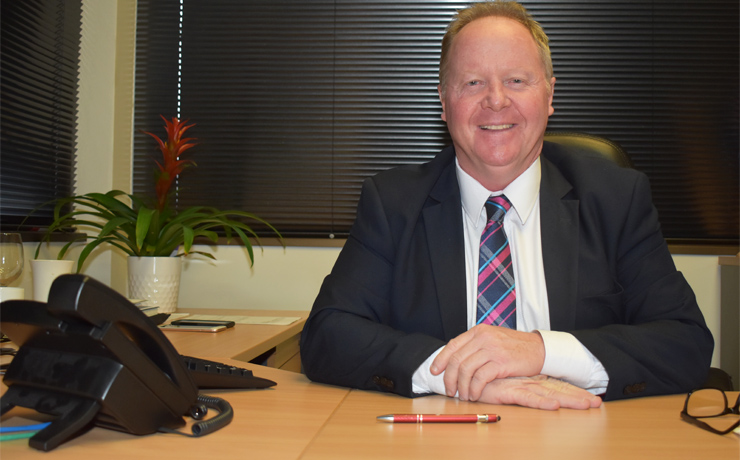
July 1, 2021
South Burnett Mayor Brett Otto will vote against the Council’s 2021-22 Budget when it is handed down on July 14 unless his fellow councillors agree to continue finding savings.
The Mayor made the shock announcement at Wednesday’s Budget planning meeting.
Traditionally, the annual Budget has always been the responsibility of the Mayor and the Mayor’s support is implied.
But under legislative changes, the Budget is now the responsibility of both the Mayor and councillors and the Mayor is free to lodge an opposition vote.
At the moment, councillors are planning to hand down a 1 per cent rate increase for 2021-22, based on the rate in the dollar.
But with the third year of property valuation rises due to come into effect on July 1, many rural ratepayers will see their rates bill increase by as much as 3.18 per cent.
The Council began preparing the 2021-22 Budget in late April.
At that time – after last year’s zero per cent rate rise – councillors expected the Budget would have a deficit of $4.2 million.
However, this has now been reduced to about $3 million after councillors found several areas of savings in the books.
Mayor Otto reminded councillors the cost to Council’s finances of handing down a second zero per cent rate rise was about $300,000.
He said he would be voting against the Budget if councillors levied anything higher than a zero per cent increase because he was convinced they could find the $300,000 without reducing services through further intelligent cost-cutting.
To support his argument, Mayor Otto gave four examples of cost-saving measures councillors could investigate over the coming year:
- Using government grants such as Works For Queensland for some building renewal works – rather than ratepayer funds – could reduce Council’s $500,000 annual spend on maintaining Council buildings
- Upgrading the way weed control services were delivered could lower the $462,000 the Council spends each year, while at the same time improving its weed spraying program
- Increasing investment in staff training could reduce the hundreds of thousands of dollars the SBRC spends on consultants each year while providing staff with opportunities to grow and develop, and
- Reviewing Council’s fleet of more than 100 vehicles – which currently costs in excess of $1.7 million a year in running costs and depreciation – could also yield substantial savings.
Mayor Otto said he had identified an example where savings could be made on the use of contractors.
“We are paying an outside consultant / contracting firm $405,000 per annum to provide one person for 40 hours per week, while one of our neighbouring fellow rural councils does this with a local employee for $120,000 per year,” he said.
Mayor Otto also reminded councillors the South Burnett’s rates were already “up there” and used his own house as an example:
“The valuation on my residential property in Kingaroy is $74,333,” he said.
“Based on the current year’s rate in the dollar for Kingaroy residents of 2.40 per $100 (or 2.4 per cent), I pay $1784 in general rates.
“lf my property was in Nanango and valued the same, at their rate of 3.11 I would pay $2315, and in Murgon at 3.86, I would pay $2869 in general rates plus sewerage, water and waste collection costs.
“But if my property was in the following towns and of the same value, I would pay the following:
“In Gympie – where the rate in the dollar is 1.15 – I would pay $1241 ($543 less than Kingaroy, $1074 less than Nanango and $1628 less than Murgon).
“And in Warwick or Stanthorpe – where the rate in the dollar is 1.48 – I would pay $1155 ($629 less than Kingaroy, $1160 less than Nanango and $1714 less than Murgon).”
Mayor Otto said he also thought a proposed price increase in second pedestal charges should be deferred for at least 12 months while councillors examined a charging system used by Gympie Regional Council.
The SBRC has proposed increasing second pedestal charges for non-residential properties by $22 in 2021-22, and a further $22 in 2022-23, in an effort to recoup sewerage costs from high-usage State Government groups such as schools and hospitals.
However, this one-size-fits-all approach will also affect private schools, hotels, motels, caravan parks and the owners of unit blocks.
“It is an increase of $22 per year per additional pedestal. This means that for a caravan park that has, say, 60 pedestals, the annual cost will rise from $12,420 to $13,740 in year one and to $15,060 in year two,” Mayor Otto said.
He had been informed Gympie Regional Council used a different system which let that Council levy higher charges on government end-users without affecting local accommodation operators, and he wanted to defer the increases for a year so that could be investigated.
Cr Kathy Duff said she supported the Mayor’s initiative and shared his belief further savings could be found in other areas of Council’s expenditure that have yet to be examined.
However, Deputy Mayor Gavin Jones and Cr Scott Henschen said they were “comfortable” with a 1 per cent rate rise and believed ratepayers expected it.
Cr Kirstie Schumacher reminded the Mayor that a Queensland Treasury Corporation official had told them a zero per cent rate rise would be “irresponsible” at last week’s Australian Local Government Conference in Canberra.
Mayor Otto agreed, but reminded Cr Schumacher the official had changed his view when asked if this would still apply if there were further cost savings to be found.
In the end, the debate was brought to a close by Cr Roz Frohloff who suggested the current Budget draft documents be accepted for information, which would allow Councillors more time to consider the Mayor’s proposal.
Council’s next meeting will be the Infrastructure Standing Committee scheduled for next Wednesday (July 7).
[UPDATED]
























They could have saved money by erecting the 24 “welcome to” town signs (12 towns x 2 signs each) correctly in the first place.
Wondai, for example, was erected, excess concrete and dirt just left on the ground, now the Wondai signs have been moved and raised on to a concrete and gravel plinth, one relocated across the road from its original position.
No doubt other towns will get the same treatment.
Another “job” that appears to be a “good’un” is gravestone cleaning, done by various people on a rotation basis. My observations have been it’s a great opportunity for a nap in the council ute.
Thank you, Mayor Otto, for standing up for your constituents and I can only hope that with the brave support of Cr Duff and maybe Cr Schumacher and Frohloff you will prevail for once.
Everyone has been doing it tough during droughts and COVID. So for many people even 1 per cent (which could in fact be quite a bit more) more rates to pay will be difficult.
And to add to Peter Ward’s comment: unnecessary trips by council workers should be avoided.
My observation: Two council vehicles turning up way down at the Emu Creek Camping Ground and Day Use Area around lunchtime within half an hour with two people in each car. Coming all the way from Kingaroy, almost 100km one way, to do what? Empty a couple of bins, check the toilets and add some paper? Well… it’s a nice spot… so why not drive there for a quiet lunch break!
Very happy for council to keep looking for savings. Given the savings are all only “possible”, perhaps a small increase which is quarantined is the way to go.
I understand the difficulty. Different increases in valuations effect individual ratepayers. I wish I had the answer. Maybe the valuations used to calculate rates could be locked in for the term of the council.
Like everyone, council is suffering from a large increase in the cost of raw materials. If we accept the proposed increase, we could keep it aside to cover any overruns in say road material increases. We could use it to ensure we don’t have to reduce services or increase debit.
Above all, keep look for savings. Wouldn’t it be great if this time next year we saw services delivered, costs contained and savings found to reduce debt?
100 vehicles for an organisation with 300 staff does sound a bit excessive. Has anyone examined the alternative of paying a car allowance to some staff for using their own vehicles? And yes, using grant funds to pay some of the costs of routine building upgrades sounds sensible and really should be looked at.
If the difference between a 0% rate rise and a 1% rate rise is $300,000, I’m sure that money could be found just in these two areas alone. So good on you, Mr Mayor, for raising these issues.
I think this merits the support of all other Councillors, and shame on any of them that don’t back this.
Congratulations to Mayor Brett Otto, under trying circumstances, for considering all rate payers. Amazing how the cost of everything continues to rise but people’s incomes, from whatever source, don’t!